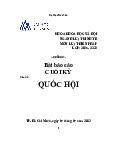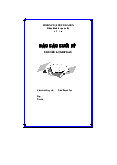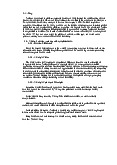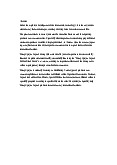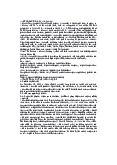

















Preview text:
RESEARCH STEPS 1.
Using the Scientific Methods
Literature review:xaminingexisting
researchrelatedtoatopicofinterest
Hypothesis:aspecific,testableprediction - Reality Example:
Step of the Scientific Method Example ObserveaPhenomenon
Astudentnoticesthatstudyinginone large block of timedoesnot help her rememberthematerial. AskaQuestion
Shewonders,“Will I understand my notes better if I review them each day or at the end of the week?” ReviewtheLiterature
Shelooksforpast researchthattestedvariousstudytechniquesandmeasured learning. FormaHypothesis
Shemakestheprediction: “Studying for 10 minutes daily will lead to recall of more
material than studying for 70 minutes once.” TesttheHypothesis
Inweek1,fiveparticipantsstudyfor10minuteseachdayandthentaketheChapter
1quiz.Duringweek2,thesameparticipantsstudyfor70 minutes in one sittingand
thentaketheChapter2quiz. AnalyzetheData
Shecomparesthedifferencesinpercentageofquestionsansweredcorrectlybetween weeks1and2. DrawConclusions
Sheconcludesthat spreading out studying over the week was more effective than
studying in a large block of time. ReviseTheory
Fromherresults,shewilldetermineifherresearchsupportsorrefutesthe
establishedtheory,orwhetherthetheorymightberefinedinsomeway. -
Real Example: psychologistDustinAlbertandcolleagues(2013)investigatedtheobservationthatadolescentsengagein
moreriskybehaviorsthanadults.
Step of the Scientific Method Example ObserveaPhenomenon
Likeus,theresearcherswouldhavenoticedthat teens seemed to engage in risky
behaviors more often than adults. AskaQuestion
Afternoticingthebehavior,itisnaturaltowonderwhyitishappening.The
researcherslikelyaskedquestionslikethis:“Whyareteenschoosingtoparticipatein
riskybehaviorsmoreoftenthanadults?”“Dotheyalwaysbehavethisway?” ReviewtheLiterature
Inordertofindoutwhatisalreadyknownaboutthistopic,theresearcherslookedfor
published studiesdealingwithteenage impulsivity, brain development, cognitive
development, and social and emotional development. FormaHypothesis
Afterreviewingtheliterature,includingtheirownpastresearch,Albertand
colleagues(2013)decidedto investigate the role of peers in adolescent decision-
making.Inthiscase,agoodhypothesiswouldbe:Teenagerswillexhibitmorerisky
behaviorswheninthepresenceofpeerscomparedtowhentheyarealone.Thisisa
specific,testableprediction,soitisagoodhypothesis. TesttheHypothesis
Atthispoint,Albertandcolleagues(2013)testedadolescentsinadecision-making
scenario.Inthisstudy,itwasadrivingsimulation.Onegroupwouldbetestedinthe
presenceofpeersandtheothergroupwouldbetestedalone. AnalyzetheData
Toanalyzethedata,theresearcherscomparedthepeerandno-peergroups’
performancesinthedrivingsimulation. DrawConclusions
Albertandcolleagues(2013)concludedthat the presence of peers caused
adolescents to make more risky decisions,whichresultedinahighernumberof
crashesinthedrivingsimulation.Theywroteascientificpaperandpublishedtheir
findingsinaresearchjournal. ReviseTheory
Basedontheresultsofthisstudy,thereisadditionalsupportforthetheorythat
teensmakemoreriskydecisionswheninthepresenceofpeersthantheymakewhen alone. 2.
Scholarly Sources (Literature Review)
Google Scholar(scholar.google.com)and PsycINFO(apa.org/pubs/databases/psycinfo) ●
Scholarly sourcemeetsacombinationoffactors: - Authored by scholars: o
Oftenhaveanadvanceddegree o
Rigoroustraininginresearchmethodology o
Aparticularspecialtyarea. o
Somescholarsconductresearchalone,butmostworkincollaborativeteams. -
Peer-reviewed journals:externalexperts(i.e.,expertswhowerenotinvolvedinthewritingoftheparticular
article,havethesamescholarlyareawiththeauthors)
review+approveanarticlebeforeit ispublished - Research evidence: o
Describetheresearchmethodologyandfindingsofaspecificscientificstudythattheyconducted o
Describethecurrentresearchliteraturerelatedtothetopic,orboth. ●
Types of Journal Articles: (determine by reading the abstract) -
Academic journal:American Psychologist, Journal of Applied Psychology -
Research journal (empirical journal): describeindetailthemethodologyusedtoconductaspecificstudyandthe
correspondingresult-“primary sources” -
Review article: criticallysynthesizetheresultsofmultiplepublished,empiricalarticlesonagiventopic+providea
comprehensivereferencelistofrelatedsources-“secondary sources” ● The Gray Literature: -
Researchreportsandotherdocumentsthatarenotpublishedinacademicjournalsaresometimescalledthegray
literature,todistinguishthemfromthescholarlyliterature. -
Someofthesereportsaregeneratedbygovernmentalandnongovernmentalagencies. - Policydocuments,speeches
,andso-calledwhite papersthatmayreport,oratleastappeartoreport,thefindings ofresearch. 3.
Reading the Scientific Literature ●
Terminology:setoftermstorefertoconceptsrelatedtoatopic -
E.g:researchersusetheterm“groupthink”torefertoaspecifictypeofdecision-makingprocessthatsomegroups follow. ●
Conceptual definitions:similaritiesanddifferencesinthewayconceptsaredefinedbyresearchers. -
E.g:theword “stress” isdefinedinatleastthreedifferentwaysintheresearchliterature:
①. torefertothenumberofmajor life eventsapersonrecentlyexperienced
②. thedegreetowhichapersonfeelsoverwhelmed
③. changesinsympatheticarousalandstresshormonelevels ●
Authors:tendtopublishmorethanonearticleorchapteronatopic+collabwithothers ●
Journals and books:asyouread,youwillencountercitationsandreferences, - E.g:appearin2ways
①. parenthetically:“...studiesofaerobicexerciseandrecoveryfromstress(Bernstein&McNally,2017)”
②. narratively:“Intheirstudiesofaerobicexerciseandrecoveryfromstress,BernsteinandMcNally(2017)found…” 4.
Structure of Research Article:
①. Abstract: briefsummaryofthearticle. +
Typicallyincludesstatementscorrespondingtoeachofthefollowingsectionsofthearticle,introduction,method,
results,anddiscussion. +
Mostjournalsimpose a strict word limitfortheabstract—usuallyafewhundredwords.
②. Introduction section:abriefsummaryoftheliteratureandthenexplainstherationaleforthestudy,includingthe
hypothesisorresearchquestion.
③. Method section:howtheauthorsconductedthestudy(participants,importantvariables+proceduresofthestudy)
④. Result section: presentthefindings(usuallywithcharts,graphs,tables)aswellasstatisticalanalysesofthedata.
⑤. Discussion section:comparestudywithpreviousresearch,explainsthestudy’scontributionstothefieldandits
implications+pointoutthelimitations
⑥. Reference section: theinformationtolocatetheoriginalsources,citation 5.
Analyzing a Research Article:
Questiontoanalyzetheresearcharticle: ●
Whatisthenature andquality oftheresearchquestionbeingaddressedinthearticle? ●
Whatisthehypothesis,orarethehypotheses,tobetested? ●
Whatarethemethods theauthorsusedtoconductthestudy(theparticipants,manipulatedandmeasuredvariables, procedures)? ●
Howdidtheauthorsanalyze thedata? ●
Whatweretheauthors’interpretationsofthestudyresults? ●
Whatwastheimportance and ofthedata? application ●
Aretherecommon results? ●
Arethereareasofagreement or among disagreement differentstudies? ●
Dotheauthorsrefertocommonlyacceptedtheoriesinthefield?Dothestudies’findingssupportthesetheories? ●
Whatgaps (limitationsorunansweredquestions)remainintheliterature?Whatkindsoffuturestudiesmightaddress thesegaps? ●
Whatmethods andmeasurements doresearcherstendtousewheninvestigatingthistopic?Couldthesemethodsand
measurementsbeusefulforyourstudy? ●
Whatchallengesorlimitations doresearcherstendtoencounterwheninvestigatingthistopic?Howdotheymanage these issues?
Types of Research Question: ●
Numeric value of variable.
E.g:whatpercentageofwomenintheUnitedStatesaged40to49haveanIQof120orabove?Or,whatistheaveragetime
thata6-week-oldbabysleepsperday? ●
Associative Relationship between variables.
E.g:doestakinga5-minutebreakeveryhourincreaseproductivityatwork?Or,whichofthreetherapeuticapproaches
causesthegreatestreductioninanxiety?
Basic and Applied Research
Basic research isdesignedtogainabetterunderstandingofaphenomenon,simplyforthesakeofincreasingknowledgeand understanding. - E.g: o howfatcellswork, o
whethercertainrewardsincreasecertainbehaviors,or o
howpeopleprocessinformationwhileinmotion.
Applied researchisdesignedtoaddressspecificpracticalproblems. - E.g: o
aprescribedexerciseprogramiseffectiveinreducingtheneedformedicationamongpeoplewithType2diabetes, o
oneleadershipstyleismoreeffectiveinincreasingemployeeproductivitythananother,or o
thedistancebetweenahighwayexitsignandthecorrespondingexitramppredictsthenumberofvehicle
accidentsnearthoseexits. KEY TAKEAWAY: ●
Meta-analysis:Aquantitativesynthesisofabodyofresearchonatopicthatcombinestheresultsofpreviouslypublished studies. ●
Value:Themathematicalmagnitudeorquantityofavariable. RECOGNIZE VARIABLES
1. Qualitative and Quantitative Variables: +
Qualitative variables:categorizedanddescribed +
Quantitative variables: measuredandordered E.g: Scenario 1:
Distractions, and what causes them, are important topics in educational research. For example, a quick visit to a coffee shop will
make it obvious that many students attempt to study where there is background music. Even in a library, students wearing earbuds
are common. But, is this music a distraction that hinders memory encoding? To investigate, we might ask participants to study a
topic in psychology with half assigned to a room where background music was playing and the other half assigned to a room that
was quiet. To measure performance, we might give each participant a 10-item quiz about the topic that they were attempting to
learn in the study room. From this scenario, take a moment to identify the variables and their type before reading on. Scenario 2:
At our core, we are social animals and, at times, just the presence of others can have an effect on how we behave. A popular topic in
psychology is how people behave in crowds under different contexts. For example, suppose you were walking through the park and,
in the midst of a crowd, you notice a person fall and then have difficulty standing. Would you step over to help? Would your response
be different if the person in need was different from you, maybe a different age group, socioeconomic status, or ethnicity, or maybe
someone who was unhoused? Most people will say they would be helpful in this situation, but would this be born out in their actions?
To investigate, we might ask for the help of a confederate to act out a fall in a crowd of bystanders where the confederate either was
or was not a member of the participant’s ingroup. To assess responsiveness to the confederate’s fall, we might record the time that
elapses between the fall and the first step the participant made following the fall. From this scenario, take a moment to identify the
variables and their type before reading on.
2. Operational Definition of Variables -
Operational definition:awaytodefinethevariableinobservable,concreteterms.(todefineanabstractvariable) o
E.g:the“Hypothesis”columnoftheOperational Definitions Tableliststhreehypothesesderivedfromthe
similarity-attractiontheory.
Operational Definitions Table Hypothesis Operational Definition Operational Definition for Similarity for Attraction
Thosewithsimilarpersonality traitswillspend
Number ofsharedpersonality
Amount of timespenttogether more timetogether. traits
Peoplewithsimilarphysical fitnesswillholdeach
Bodymassindex(BMI)within
Durationofdirecteye gaze other'sattention. 5points
Acouplewithsimilar social skills willhavea
Numberofsharedfriends
Length ofrelationship
healthy romanticrelationship.
Practice: Writing Operational Definitions:
①. Theexperienceofstresscaninfluencephysicalhealth.Suggestoperationaldefinitionsforthevariableofstressandthe
variableofphysicalHealth. +
Stress:Anoperationaldefinitionofstressmightbeaperson’sbloodpressurerelativetothenormalrangeofblood pressure. +
Physical Health:AnoperationaldefinitionofphysicalhealthmightbethelevelofTcellsinthebloodorthe
numberofcoldsorfluoverthepreviousyear.
②. Distractionaffectsdrivingability.Suggestoperationaldefinitionsforthevariableofdistractionandthevariableofdriving ability. +
Distraction:Anoperationaldefinitionofdistractionwhiledrivingmightbethenumberoftimesthedriverchecks newtexts. +
Driving Ability:Anoperationaldefinitionofdrivingabilitymightbespeedofresponsetotraffichazards.
③. Goodstudyhabitsreducetestanxiety.Suggestoperationaldefinitionsforthevariableofstudyhabitsandthevariableof testanxiety. +
Study Habits:Anoperationaldefinitionofstudyhabitsmightbethefrequencyofstudysessionspriortoanexam. +
Test Anxiety:Anoperationaldefinitionoftestanxietymightbeaperson’sbreathingrate.
④. Conflictoverresourcesinfluencesintergroupcooperation.Suggestoperationaldefinitionsforthevariableofconflictover
resourcesandthevariableofintergroupcooperation. +
Conflict Over Resources:theamountofaccesstowaterorfarmableland. +
Intergroup Cooperation: thelevelofresourcesharingwithinacommunityversusbetweencommunities. 3. Measuring Variables +
Reliability:givessimilarresultsovertime. +
Validity:accuracyofthevalues-actuallymeasureswhatitclaimstomeasure.
4. Understanding Reliability and Validity of Measures
Example:A researcher suggests that intelligence can be measured by shoe size. You might be wondering how shoe size can be a
reliable and valid measure of intelligence. As a test of the researchers hypothesis, you measure your shoe size today, the next day, the
day after that week, and several days over the next month. -
Fromthisactivity,would you say that your measure of shoe size is a reliable measure? o
A reliable measureisonethatgivessimilarresultsovertime. o
Measuringyourshoesize,then,isareliablemeasure:Everytimeyoumeasureshoesize(asanadult),yougetthe sameresult. -
Now, is shoe size a valid measure for the researcher’s hypothesis? o A
measureisonethatactuallymeasureswhatitclaimstomeasure. valid
Ofcourse,manypeoplewiththesame
shoesizewillhavedifferentintelligencescores,andviceversa. o
Soshoesizeandintelligencearenotrelated.Asaresult,thisisnotavalidmeasure. 6. Replication:
Test-retest reliability: performaretestofameasureunderthesameconditionstodetermineiftherepeatedmeasuresarereliable.
E.g:theeffectofcaffeineonamechanicalaptitudetest.? -
Participants:divideagroupof60participantsintotwo sub-groupsof30participants,
①. receivesacaffeinepillonehalf-hourbeforetheaptitudetest
②. istreatedidentically,exceptthatthoseparticipantsreceiveasugar-pillplaceboinsteadofacaffeinepill. -
Result: onaverage,participantswhoreceivedcaffeinescorea53 onthetest,whereasthosewhoreceivedtheplacebo
scorea48 onaverage.
→ Replication:
①. werepeattheexperiment,followingtheexactsameprocedures,butthistimeparticipantsinthecaffeineconditionaverage
55 onthetest,andparticipantsintheplaceboconditionaverage47.
②. againunderthesameconditions,butthistimewefindthattheaveragewas54 forthecaffeinegroupand46 forthe placebogroup.
Thereisvariabilityinthemeasuresforeachofthegroups
Thesemeasuresaregenerallyconsistentforbothgroups.
Themeasuresforthecaffeinegroupare53,55,and54;themeasuresfortheplacebogroupare48,47,and46.Although
thereisvariability,wealsobegintoseeapatternthatsuggeststhedifferenceswearemeasuringbetweenthegroups maybereal. 7. Types of replication: ● Direct replication:
Effortsweremadetofollowtheexactsameproceduresastheoriginalresearchwitha
new group of participants .
Findingsimilarresultsinareplicatedstudymeanstheresearchisconsistent.However,itdoesnotmeanthatthe
theoreticalargumentsofferedbytheauthorsofthefirststudyarecorrectorthattherearenotconfounding variables. ●
Conceptual replication (systematic replication):
Testthehypothesisfromtheoriginalstudyusing different methods . ●
Replication with extension:
Replicatetheoriginalstudyandextendthefindingsby adding new variablestoansweradditional questions .
Theuseofvariedtypesofreplicationmethodsadds to the weight of the evidence foratopicofinterestandhelps
developscientifictheories. 8. Replication Crisis:
Only 36%ofthereplicatedstudieshadsignificantresults,comparedto97%oftheoriginalstudies.⇒itservestounderscorethe
importanceofthereplicationprocess KEY TAKEAWAY: ●
Itisimportanttodistinguishbetweennaturalorsystematic variabilityofavariable,whichissomethingthatcantakeon
differentcategories,levels,orvalues,anderror variability,whichisthevariabilitythatoccurswhenthevariableis measured. ●
Eventhesimplestmeasurements,likemeasuringthelengthofaboardoraroom’stemperature,willbesubjectto
measurement error,whichisthevariabilitythatoccurswhenthesamethingisrepeatedlymeasured. RESEARCH DESIGN 1. Research Questions:
3basictypesofresearchquestions: o
questionsthatask about the value of a variable(e.g:whatpercentageofwomenintheUnitedStatesaged40to49have
anIQof120orabove?); o
questionsthat ask about associations between variables (e.g:doesreadingfrequencyduringchildhoodpredictthe
likelihoodofhighschoolgraduation?) o
questionsthatask about a causal relationship between variables(e.g:comparedtotakingnobreak,doestakinga5-
minutebreakeveryhourincreaseproductivityatwork?). 2. Descriptive Research Descriptive research:
Betterunderstandatopic,population,orphenomenonbyoffering information about one variable/acollectionof
variableswithoutmanipulatingvariablesorseekingdefinitivelytoestablishcauseandeffect. o
E.g: helpanswerthequestion:"Whatpercentage of high school students havebeendiagnosedwithdepression?"
Descriptivedatatypicallyincludefrequencies,percentages,oraverages.
Adescriptiveresearchdesignhasno comparison grouporrepeated measurement,yetresearchersmaystillgainvaluable information. o
Adescriptiveresearchdesignmayprovideapictureofaparticulargroupataparticulartime,whichmayhelp
researchersimprove hypothesesandbuild a foundationforlatercorrelational researchorexperimental research. Sample: subset
ofthatlargerpopulationthatisintendedtoberepresentativeofthatgroup.
Ideally,samplesaredrawnfromthepopulation
inordertoeliminatepossiblebiases, randomly
butoftensamplesaremade
upofgroupsofpeopleathand,suchaspatientsfromlocalhospitalsorstudentsfromnearbyschools.
Normal conducted in 4 ways: 1.
Observational method (field research):
Closeexaminationanddocumentationofabehaviororphenomenon.
usedinthenaturalworld
butitcanalsobeusedinalaboratory . +
E.g:observingthebehaviorofstudentsinacafeteriaorcouplesinacoffeeshop. (Natural world) +
E.g:observinganddescribinginteractionsbetweenstudyparticipantsassignedtoroles.(Lab) 2. Case study method:
adetailedandin-depthexaminationofoneora few individualsorsituations
relevantinstudyingspecialpopulationsorcontexts(raresituation/talentedpeople) 3. Survey method: + questionnaires
orinterviewstocollectbasicinformationinvarioussettings. o
E.g:pollingorganizationstocollectdataonlikelyvotersduringelectionsandbycensustakerstogather
informationonacountry’sresidents. +
Researchers use similar methodologytoanswertheirresearchquestions.Thismethodrelies on the candor of the
participantstorevealwhatissometimespersonalinformation;thisisalsooneofitsweaknesses. 4. Archival method: + archivaldata
fromhistoricalrecordsorotherresearchers
(+):participantbehaviorisnotaffectedbytheexperimenterbecausethedatawerepreviouslycollectedby someoneelse.
(-): theexperimenterhasnocontroloverhowthedatawerecollectedorhowcompleteorreliabletheyare.
2. Correlational Research Method Correlational research: ●
therelationshipsbetweentwoormorevariableswithout directly manipulatingorcontrollinganyofthevariables. ●
Variablescanbemeasuredinthefollowingways: o
self-reportbyhavingparticipantscompletequestionnairesorinterviews; o
observation whichinvolveswatchingparticipants'behaviorasithappenswithoutintervening,butrecordingkey
aspectsofwhatisobserved; o
physiological measurementbyusinginstrumentstodeterminebodilyvariationssuchasheartrate,body
temperature,brainactivity,orweight;and o
archival researchbyobtaininginformationfromofficialdocumentsorrecords,suchasthedurationofaperson’s hospitalstay. ●
Ifweknowthevalueofoneofthevariables,itmaybeusedasapredictor variabletoestimatethevalueoftheother
variable,whichisthencalledtheoutcome variable.
Correlation does not imply causation ●
Confounding variables: correlatedtothepredictorandoutcomevariables,whichiswhywecannotinfercausationfroma correlationalrelationship ●
Correlation coefficientisameasureofthestrengthanddirection(positiveornegative)oftherelationshipbetweentwo
variables.Itisusuallydenotedbytheletterrandrangesfrom−1to+1.
3. Using the Experimental Research:
Experimental research:examinesthecausal relationship betweenvariablesundercontrolledconditions. +
Theresearchermanipulates,alters,orvariesanindependent variableandmeasurestheeffectofthosechanges
onadependent variablewhilecontrolling ,which
extraneous variables
arevariablesthatareunrelated tothe
researchquestionbutthatmightaffect thedependent variable. +
Verbssuchas"measured,""surveyed,""tabulated,""recorded,"or"assessed"indicatethattheresearcher
measured thevariable. +
Verbssuchas"assigned,""instructed,""presented,"or"delayed"indicatethattheresearchermanipulated the variable. A two-group design:
①. Researchersuserandom assignmenttoensurethateveryparticipanthasanequalchanceofbeingplacedinan
experimentalgrouporacontrolgroup
②. researchersmanipulate theindependentvariableacrossthegroupswhileeither eliminating other variables from
thestudyorholdingthemconstantacrossthegroups.
③. Participantsintheexperimental groupundergosomekindoftreatment,intervention,orexperience,while
participantsinthecontrol groupdonot. Single-factor designs: +
a single independent variable,orfactor,withtwoormorelevels,orgroups+usedtotestfordifferencesbetween experimentalconditions. ●
factorial design (multi-factor designs): +
multipleindependentvariables,orfactors +
Iftherearetwovariables,onewithtwolevelsandtheotherwiththree,thedesigniscalledatwo-by-three(or2✕
3)factorialandthenumberofconditions(or
)inthedesignissix.Iftherearethreeindependentvariables, cells one
withtwolevels,onewiththree,andanotherwithfour,thedesigniscalledatwo-by-three-by-four(or2✕3✕4)
factorialandthenumberofcellsinthedesignis24.
(+):thefactorialdesignisthatitallowsresearcherstoconsider the joint effectsofmultipleindependentvariables.
QUASI-EXPERIMENTAL RESEARCH METHOD:
Quasi-experimental research: +
Resemblesexperimentalresearchexceptthattheinvestigatorcannot randomly assign unitsorparticipantstoconditions,
cannot generally control or manipulate theindependentvariable,andcannot completely eliminate theinfluenceof extraneousvariables. +
Quasi-experimentaldesignsleadtoassociation claims,notcausationclaims.
